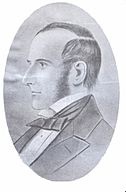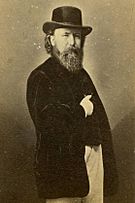James Stephens (Fenian) facts for kids
Quick facts for kids
James Stephens
|
|
|---|---|
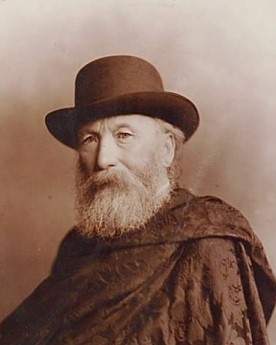 |
|
| President of the Irish Republican Brotherhood | |
| In office 17 March 1858 – December 1866 |
|
| Succeeded by | Thomas J. Kelly |
| Personal details | |
| Born | January 26, 1825 Kilkenny, Ireland |
| Died | March 29, 1901 (aged 76) Blackrock, County Dublin, Ireland |
| Resting place | Glasnevin Cemetery |
| Occupation | Civil engineer, teacher, translator, newspaper publisher |
| Nickname | "Seabhach Siulach" (the Wandering Hawk) |
James Stephens (Irish: Séamus Mac Stiofáin; 26 January 1825 – 29 March 1901) was an important Irish Republican leader. He helped start a secret group in Dublin on 17 March 1858. This group later became known as the Irish Republican Brotherhood (IRB). Stephens played a big part in trying to gain Ireland's independence from British rule.
Contents
Early Life and Education
James Stephens was born in Kilkenny, Ireland, on 26 January 1825. His parents were John and Anne Stephens. He had five brothers and sisters. His father worked as a clerk and also owned some small properties.
James's father wanted him to have a good education. James went to St. Kieran's college for a time. He loved to read and learn new things. When he was 20, he became a civil engineer. He worked on the Limerick and Waterford Railway in 1844.
Stephens became interested in politics as a young man. He didn't like the peaceful approach of some Irish leaders. He preferred the ideas of the Young Ireland movement. This group wanted more direct action for Irish freedom.
Ireland in the 1840s
In the 1840s, Ireland faced a terrible time called the Great Famine. Many people suffered and died. This period made many Irish people want change. Leaders like John Mitchel and James Fintan Lalor encouraged people to fight for their rights. Stephens agreed with their strong republican ideas. He even started secretly training for a fight.
The 1848 Rebellion
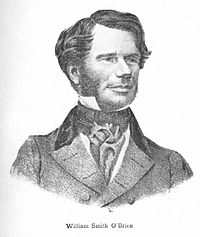
In 1848, revolutions were happening all over Europe. This inspired many in Ireland. After a leader named John Mitchel was sent away, William Smith O'Brien took charge of the Young Irelanders. O'Brien came to Kilkenny to ask people to join a fight for freedom.
Stephens and his father went to a meeting. They heard that someone was trying to arrest O'Brien. Stephens helped to stop the arrest. This was the last time he saw his father.
Joining the Fight

Stephens decided to join O'Brien's group. He became an aide de camp (a personal assistant) to William Smith O'Brien. He met other important figures like Charles Kickham, who would later become a leader of the IRB.
The rebels had a small fight with police in Killenaule. Stephens helped build barricades and was ready to fight. Later, in Ballingarry, they had another standoff with police. The police took refuge in a house with children inside.
After these events, Stephens was a wanted man. To avoid arrest, he pretended to be dead. He then escaped to France. He lived there for the next seven years.
Life in Paris
In Paris, James Stephens and John O'Mahony lived as exiles. They earned money by teaching and translating. During his seven years in Paris, Stephens focused on three things: staying safe, learning, and understanding how to plan secret movements. Paris was full of secret political groups. Stephens learned a lot from them about how to organize a revolution.
In 1853, O'Mahony went to America. He started a group there called the Emmet Monument Association.
Journey Through Ireland
In 1856, Stephens returned to Ireland. He walked about 3,000 miles across the country. He met many people who had been part of the 1848 rebellion. These meetings helped him plan for a new organization.
Founding the IRB
In late 1857, a message came from New York. It was from the Emmet Monument Association. They asked Stephens to start a group in Ireland. Stephens agreed, but he wanted full control and money to start.
On 17 March 1858, Stephens received the money and agreement. That evening, on St. Patrick's Day, the Irish Republican Brotherhood (IRB) was officially started. The first oath for the group was written by Thomas Clarke Luby under Stephens' guidance.
The first meeting included Stephens, Luby, Peter Langan, Charles Kickham, Joseph Denieffe, and Garrett O'Shaughnessy. Later, members of the Phoenix National and Literary Society also joined.
Travels to America
Stephens traveled to New York in October 1858. He met with Doheny and O'Mahony. He was successful in bringing together different Irish groups in America. He helped turn them into a strong political and revolutionary force.
Stephens kept a diary during his time in America. It covers the period from January 1859 to March 1860. This diary is now kept in the Public Records Office in Northern Ireland.
The Irish People Newspaper
In 1863, Stephens decided to start a newspaper. It was called The Irish People. The newspaper's office was in Dublin. The first issue came out on 28 November 1863.
The newspaper's staff included Kickham, Luby, and Denis Dowling Mulcahy. John O'Leary was the editor. The paper helped spread the IRB's message.
Arrest and Escape
In July 1865, plans for a rising in Ireland were found by the authorities. An informer helped the police. On 15 September, the police raided the offices of The Irish People. O'Leary, Luby, and Jeremiah O'Donovan Rossa were arrested. Kickham was caught later.
Stephens was also caught and put in prison. But with the help of some prison guards, he escaped in less than two weeks. He fled to France. The last issue of The Irish People was published on 16 September 1865.
Later Life and Legacy
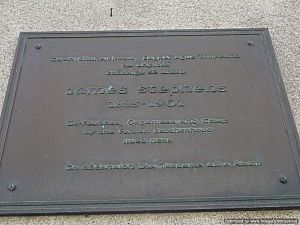
James Stephens died on 29 March 1901 in Blackrock, Dublin. He was buried in Glasnevin Cemetery. Many veterans of the 1867 rebellion were his pallbearers.
Honors and Memorials
- His childhood home in Kilkenny still stands. A plaque marks it as his birthplace.
- Stephens Barracks in Kilkenny is named after him. It is the headquarters of the 3rd Infantry Battalion.
- The Ballina Stephenites GAA club is named after Stephens. Their grounds are called James Stephens Park.
- The James Stephens GAA Club in Kilkenny city is also named in his honor.



